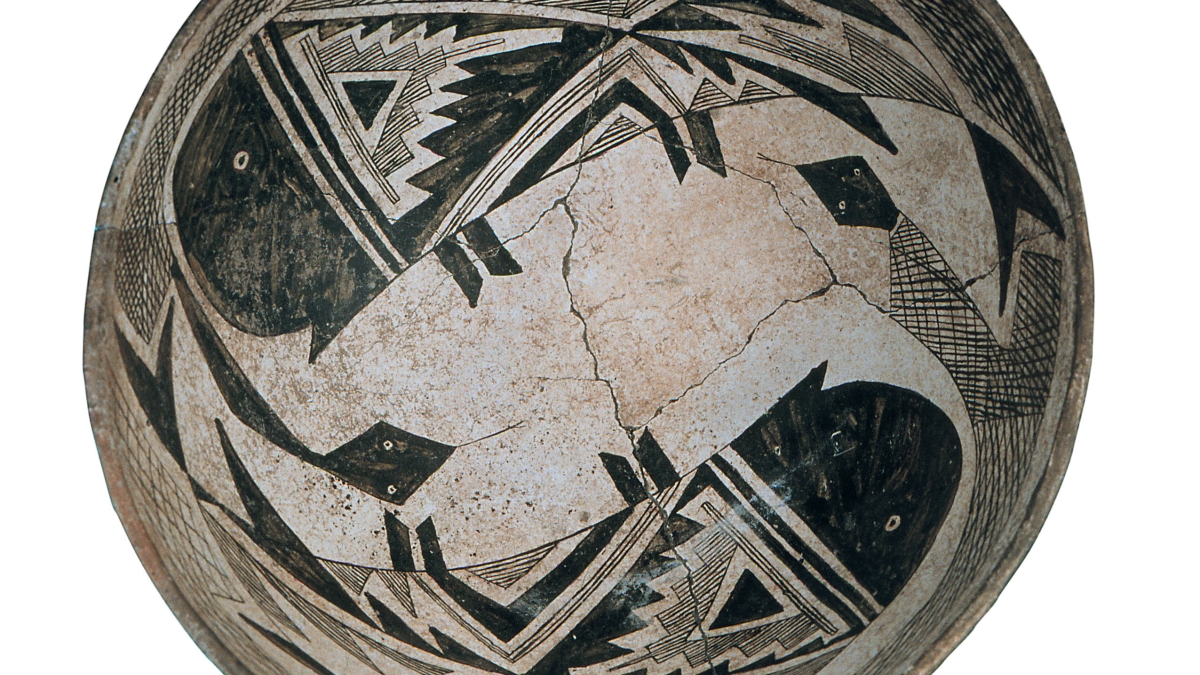With elegant designs, tied together with fine lines and details that pop off the surface, Mimbres pottery is some of the most beautiful art of the prehistoric Southwest. The china service at the historic El Tovar Hotel’s dining room at the Grand Canyon was in Mimbres style.
It’s beloved today for the designs: antelope, fish, jackrabbits, lizards, bats, scorpions, bighorn sheep, parrots and sacred figures. And that’s where most of the attention on Mimbres pottery has been focused: what’s depicted and how cool or charming it is.
But pottery and Mimbres social organization hadn’t been brought together. Academically, the pottery lived in a vacuum of its own.
Now, a new study by researchers at Arizona State University’s School of Human Evolution and Social Change highlights the meaning behind the painted designs.
“Everyone loves Mimbres pottery,” said lead author Michelle Hegmon. “It’s really easy to see; this has got a rabbit, this has got a duck, this has got some kind of sacred figure. But taking it much further than that is complicated, by all sorts of factors. … The analysis of the designs was either about artistry or some sacred meanings, and then there was the analysis of society which didn’t have much to do with pottery. … This study is a synthesis.”
The meaning of the design is not necessarily what the design depicts. You look at Impressionist art, and the meaning is not a water lily or a bridge: It’s the whole way of depicting things. Mimbres pottery is similar.
In archaeology, you’re always looking for patterns. With Mimbres, it’s tough to explain the designs because there’s nothing else in the Southwest like them.
“What we did in the study is bring together a whole series of analyses,” Hegmon said. “Some results are new and some are what archaeologists have been saying for a while.”
One fact that’s never been demonstrated is that distribution of the pottery had strict boundaries. It didn’t get traded or carried hither and yon. Inside the Mimbres area (southwestern New Mexico, near Deming, from 1000 A.D. to about 1130 A.D.), there’s almost no other styles of pottery. Outside the Mimbres area, there’s no Mimbres pottery.
“That is very unusual in the Southwest,” Hegmon said. “It’s pretty much all or nothing. Ninety-some percent on Mimbres sites and usually 5% (from) outside the region.”
The area was a good place to live. There were rivers and good farm land. People moved in, people moved out. But the movement of people doesn’t seem to have affected the movement of the pottery.
“When they came into the region, they used the pottery,” she said. “When they left the region, they didn’t take much with them. It’s not a completely new idea, but ours is the first study that really showed that definitively, with a lot of quantitative data rather than an impression.”
Just about every attribute they studied, from the types of animals to the geometric designs, is distributed homogeneously through the region. “Pretty much everyone has the same suite of things,” Hegmon said.
The designs are all painted the same way. There was one way to paint a jackrabbit and one way to paint a sheep. Most of them are in profile, except for reptiles.
“Why is it so beautiful, and what does it mean? The two seemed to come together.”
The Mimbres farmed and buried their dead with their pottery. It was both a way of claiming their land and how they were organized. It was an acknowledgement of a whole cultural system. The pottery was an important part of the land tenure system, which made the potters more important. In turn they made more elaborate designs.
There are some analogies to assimilation – an immigrant who moves to America starts mowing the lawn and eating hot dogs on the Fourth of July.
“What the pottery means is, in short, ‘I belong here,’” Hegmon said. “It means I’m part of this Mimbres system; I accept it. … It all comes together in a really neat package. Pottery was part of life in the Mimbres region.”
The paper was recently published in American Antiquity.
Top image: Mimbres pottery, courtesy of the collection of the School of Human Evolution and Social Change.
More Arts, humanities and education

ASU professor, alum named Yamaha '40 Under 40' outstanding music educators
A music career conference that connects college students with such industry leaders as Timbaland. A K–12 program that incorporates technology into music so that students are using digital tools to…

ASU's Poitier Film School to host master classes, screening series with visionary filmmakers
Rodrigo Reyes, the acclaimed Mexican American filmmaker and Guggenheim Fellow whose 2022 documentary “Sansón and Me” won the Best Film Award at Sheffield DocFest, has built his career with films that…

Pen Project helps unlock writing talent for incarcerated writers
It’s a typical Monday afternoon and Lance Graham is on his way to the Arizona State Prison in Goodyear.It’s a familiar scene. Graham has been in prison before.“I feel comfortable in prison because of…


